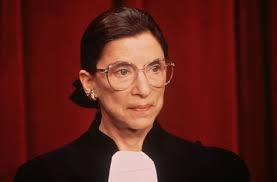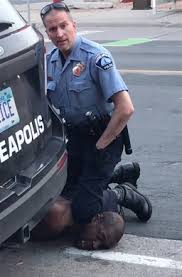Iconic Deaths and What They Mean: George Floyd and Ruth Bader Ginsberg
2020 is a year that will be remembered for its many distinctive features—the global reach and lethality of the COVID pandemic, worldwide protests against racism, and likely, to come, the outcome and aftermath of an American presidential election with likely severe worldwide reverberations. Yet one of the least conceptualized aspects up until now is the occurrence of two very different iconic deaths.’ By according an iconic status to an individual’s death is to acknowledge its historic impact. In one case, that of George Floyd, victim of police murder on May 25th, the impacts of his shocking death were immediate and astonishing for their scope and potentially transformative effects on how human people treat one another. Floyd’s death was iconic while hiss life had no broad historic significance.
With Ruth Bader Ginsberg her death brought to an the experience of an iconic life, a legendary figure who made creative use of law to overcome gender discrimination. Her death was also an iconic event for multiple reasons, perhaps most salient as a result of its occurrence at a moment where it could profoundly affect the orientation of the U.S. Supreme Court for decades. Had RBG died six months earlier or later her death would not have caused such a stir, and her historic significance would focused on celebrating her lifetime achievements, memorialized by making her the first woman to lie in state on the steps of the U.S. Capitol. By dying when she did. RBG produced a constitutional and consequential crisis over the appropriateness of rushing to confirm a successor prior to the presidential election scheduled for November 3rd. Actually, even if she had been a rather undistinguished justice of the Supreme Court her death at this time would be hugely significant if not iconic. Unlike Floyd, whose death was a result of a heinous police crime, Ginsberg died of natural causes, and so her death becomes iconic not because of its character but because of its potentially momentous impact on the role of the U.S. Supreme Court in presiding over the judicial responses to controversial social and economic policies for coming decades. The fact that she was the first woman to lie in state on the steps of her the Capitol is a recognition of her iconic life, and was not occasioned by the timing or unrelated importance of her death.
In the annals of American experience, we have to go back to Martin Luther King, Jr. assassination to find a somewhat comparable case of an iconic life followed by an iconic death. In King’s case the assassination of this non-violent charismatic figure sparked riots and led to a new surge of support for the civil rights movement that had been his life’s work. King, like Floyd, was the victim of a criminal act, which in both cases sparked to explosive political responses that tested the resilience, flexibility, and core values of the governing political framework in the United States.
The only recent comparable case to that of Floyd is the self-immolation of Mohamed Bouazizi in the remote interior Tunisian town of Sidi Bouzid on December 17, 2010, and 28 days later after an escalating series of protest events throughout the country, the dictator of 23 years, Zine El Abidine Ben Ali, fell from power and fled the country. The death of this heretofore anonymous street vendor not only sparked a successful revolution surge against the Tunisian dictatorial regime but led directly to various types of massive protest activity that rocked the established order throughout the Arab World. These uprising in turn gave rise to a variety of violent reactions, principally leading in some national instances to a counterrevolutionary return to oppressive patterns of governance and in others to prolonged civil strife. Without belittling the anguish of family grieving after such death, the life of Floyd, as with Bouazizi became publicly notable only due to the manner of his death, and the aftermath that occurred; had either man died naturally or in a barroom brawl their lives would have been known only to his family and circle of acquaintances. which was also the case for both men.
The manner of Floyd’s death was iconic, and not only because of its tumultuous aftermath, but because it also exposed the underlying reality of the victimization of people of color due to police brutality. In this sense if Floyd’s death did not have this metaphorical resonance it might have been briefly newsworthy as in earlier comparable instances, but soon faded from view, depriving his life and particularly his death of such lasting value. Floyd’s death became iconic because it was not an isolated event, but came after a series of police killings of blacks under incriminating circumstances and leading to coverups and evasions rather than indictments and convictions. Floyd’s death, in the context that occurred, given added veracity as his dying was seen by millions as a result of a video, which helped create a tipping point from which outrage over police abuse mutated from a series of incidents to a plausible diagnosis of ‘systemic racism,’ which called for remedial justice that went beyond police reform to the entire socio-economic structure that denies equality to racial minorities.
Why should we accord attention to iconic deaths? By considering the cases of Floyd, King, Bouazizi we come to understand that certain modes of dying can under certain circumstances provide the spark that produces revolutionary upsurges. Such upsurges are expressive of simmering or dormant underlying condition of injustice or dissatisfaction that had invisibly reached the outer limit of collective patience. This invisibility accounts for the magnitude of the reaction being regarded as unexpected, a surprise, and even a mystery.
In RBG’s case her death only becomes iconic because of the unusually ruthless and reckless opportunism of the leader and his political party that seeks to take partisan advantage of an opportunity to promote to the Supreme Court a reliable ideological ally while still holding the reins of power, which risk being lost in the weeks ahead through either the defeat of Trump or the loss of Republican control of the Senate. There would still remain the lame duck gap between the election of a new president and the inauguration of the next president on January 20, 2021 where it would still be possible to thwart the normally legitimate practice of allowing the electoral choice of the people make such a judicial appointment. Here it is particularly vital as the Court is so evenly balanced, and the undisguised Republican intention is to fill the now vacant seat with a judge whose legal philosophy on wedge issues is almost diametrically opposed to the views held by Ginsberg. She may be receiving national honors by flying flags at half-mast or by having her body lie in state but her judicial legacy is in the process of being dishonored, perhaps solely because of the untimeliness of her death.
Iconic deaths are rare, and much rarer than iconic lives. There are other notable violent and unnatural deaths of Americans who had led iconic lives. Such deaths give the social order a temporary shock effect and have been the occasion of mass grieving, commentary, and retrospective assessments, including those of John F. Kennedy, Robert F. Kennedy, and Malcolm X. Yet none of these deaths were iconic in the sense meant here–producing such an immediate and significant post-mortem historic impact. We remember these men for their lives and untimely and disturbing deaths that do sometimes create a sense of long-term societal loss, but do not spark an immediate societal tremor. For instance, some have suggested that assassination of the Kennedy brothers did have a lingering depressive effect on American political life, possible culminating in the cynical demagoguery of Donald Trump.
Sometimes, events rather than persons, can have an iconic impact as was the case with the Rex Cinema in relation to the 1978 Iran Revolution or the reaction to the Gaza collision of an IDF truck with a car in Jabalia Refugee Camp killing four Palestinian passenger, and sparking the First Intifada in 1987. Whether persons or incidents, the iconic dimension arises because of underlying circumstances rather than by design. The 1960s public self-immolations of Buddhist monks in Saigon tried deliberately to give death a sense of iconic urgency in reaction to the growing American military presence in country. Some close observers felt that the fate of the Saigon regime and the Vietnam War was decided by these ultimate acts of individual self-sacrifice, modes of protest with an iconic resonance in a Buddhist cultural setting that would not be experienced by comparable religious expressions of resistance in the West.
This interest in iconic deaths, and recourse to this terminology, is to achieve a better understanding of non-incremental change in underlying political circumstances where normal channels of change have failed to address perceived injustices. Such circumstances can simmer for decades, and even longer, until a raging fire breaks out unexpectedly, and an iconic death becomes the animating cause. Of a different nature is the iconic death of RBG that has an almost coincidental historic significance because of peculiar existing conditions of the constitutional system that create a strong temporary incentive to change the course of national history, an opportunity that might be lost if not acted upon with a ruthless sense of immediacy. Such a death gives insight into the character of the American political and governmental system more than to the dynamics of change.





This might take you back. Richard, are you the same Richard Falk who, back in the 60’s, had an apartment at 78 Bank Street—at Bleeker Street —in New York City’s West Village that you sublet to a Harriet Hawkins? Well, when she was about to marry and move to Japan she let me take over that sublet which I don’t think was even technically legal. I was introduced to her by another tenant in that building, Michael Cirigliano with whom I worked in the film business. Part of my responsibility was to take care of your white Persian cat named Snee Snee. I attended Goddard College a very small “John Dewey” school in Vermont so I lived in that ultra progressive social justice world for a time and “hung around” with children of some major players on the “world stage” like Dave Teller son of physicist Edward Teller,; Eric Saarinen son of one of the giants of 20th century architecture Eero Saarinen; a guy whose name I forget whose mother was the publisher/editor of Foreign Affairs Magazine, the periodical of The Council On Foreign Relations; Susan Halper my girlfriend and daughter of Sam Halper the Caribbean Bureau Chief of Time Magazine who lived some of her formative years with her parents in the Puerto Rico Governor’s Mansion with her Godfather then Governor Luis Munoz Marin; Steven Calt, whose mother was B.F. Skinner’s sister; and several more close friends who became major published authors of a wide variety of non-fiction titles. Anyhow, I know you are very busy so thanks for taking the time to read this. I am Gary Kratman, originally from Boston’s North Shore now living in Los Angeles for the past 49 years. Please let me know if you are the Richard Falk whose apartment I once lived in. Thanks so much.
At first I thought I was the ‘Richard Falk’ you were seeking because around that
time my gf, later my wife, had an apartment on Bank Street, but not at the Bleeker St.
side. Her name was Florence Gross, involved with theater. I had some slight contact
with some of those whom you mentioned as I was a member of CFR and through Princeton
had some contacts with a range of authors. Sorry to disappoint you! I am currently living
in Turkey, and will remain until the pandemic subsides, then return to our home in Santa
Barbara. With my greetings, and glad to learn there were a bunch of ‘Richard Falk’s’ wandering around
Bank St. in the 1960s!
Richard